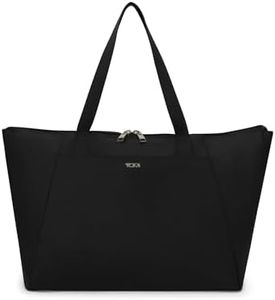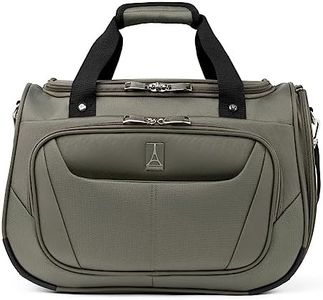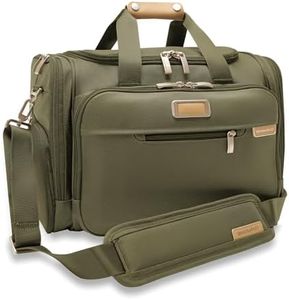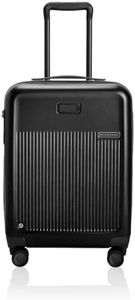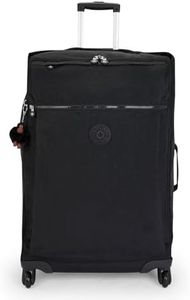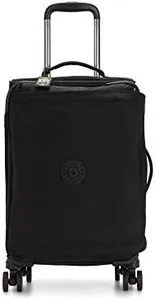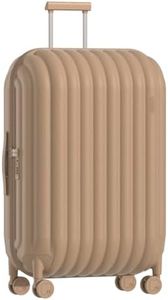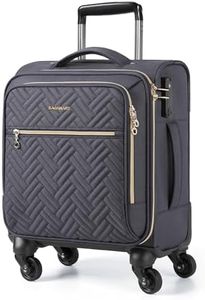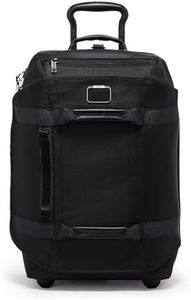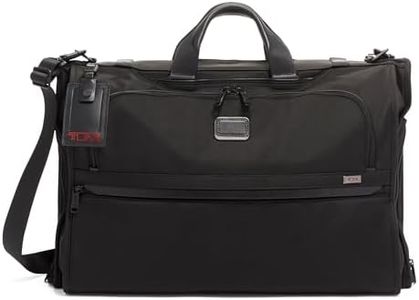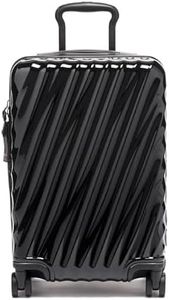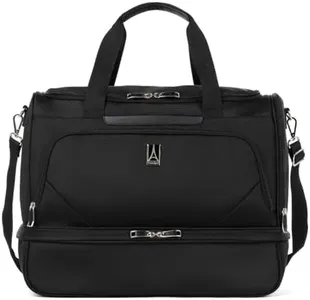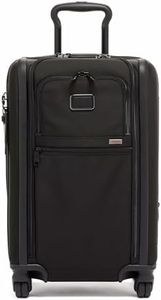10 Best Airline Carry On Bag 2025 in the United States
Our technology thoroughly searches through the online shopping world, reviewing hundreds of sites. We then process and analyze this information, updating in real-time to bring you the latest top-rated products. This way, you always get the best and most current options available.

Our Top Picks
Winner
TUMI Alpha Continental Dual Access 4-Wheeled Carry-on Luggage - Rolling, Lightweight Suitcase - Secure Suitcase with Lock - Black/Gold
Most important from
72 reviews
The TUMI Alpha Continental Dual Access carry-on bag is designed with thoughtful features that suit frequent flyers and business travelers looking for a reliable and smart suitcase. Its size (about 22 x 16 x 9 inches) fits most airline carry-on requirements, while weighing nearly 12 pounds, it’s on the heavier side compared to some lightweight options. The material and build quality from TUMI are known to be durable, with protective bumper rails adding extra defense against rough handling. Mobility is strong thanks to its 4-wheel system and a patented handle design, which makes rolling and steering the bag smooth and effortless in tight airport spaces.
One standout feature is the dual-access front lid, allowing you to reach essentials quickly without opening the entire suitcase—great for organization and convenience. Inside, compartments and a hanging mesh zipper pocket help keep items neatly arranged, and the included USB-C charging port is a handy tech addition for charging devices while on the move. Security is well-covered with a built-in TSA combination lock, reassuring travelers about the safety of their belongings.
The bag does not mention expandability, which might limit packing flexibility if you tend to bring extra items. Its weight could be a concern if you prioritize ultra-light luggage. The premium price and sturdy build reflect a focus on quality and durability rather than ultra-light travel. This carry-on is an excellent choice for those who value smart organization, security, and smooth handling, though lighter or expandable options might be better for travelers with different priorities.
Most important from
72 reviews
TUMI - Just In Case Tote - Foldable, Lightweight and Compact, Packable Travel Bag - Folds Into Included Pouch - Large, Black with Gunmetal Hardware
Most important from
172 reviews
The TUMI Just In Case Tote is a lightweight and foldable travel bag designed for convenience and easy storage, making it a great backup option for travelers who want an extra carry-on that fits into larger luggage. Weighing just 15 ounces and folding into a small pouch, it is ideal for those needing a compact bag for unexpected use at the airport or on short trips. Made from durable nylon, it offers good resistance to wear and tear, which benefits frequent travelers.
The bag features a double-zip entry and an open pocket for basic organization, while the shoulder straps and Add-a-Bag strap provide comfortable carrying and easy attachment to other luggage. Compared to traditional airline carry-on bags, it has fewer compartments and does not offer expandability, so it may hold less or organize belongings less extensively. Security features are minimal, with no locks or anti-theft elements included. This tote is suitable for travelers seeking a lightweight, packable bag to use as a secondary carry-on or shopping bag rather than a primary airline carry-on with extensive storage needs.
Most important from
172 reviews
Travelpro Maxlite 5 Softside Lightweight Underseat Carry-On Travel Tote, Overnight Weekender Bag, Men and Women, Slate Green, 18-Inch
Most important from
4943 reviews
The Travelpro Maxlite 5 Softside Underseat Carry-On Tote is a great option if you want a lightweight and compact bag that fits under most airline seats. Weighing only 1.6 pounds and measuring 18 x 11 x 8 inches, it’s easy to handle and meets common size requirements for underseat luggage. The polyester fabric has a water-repellent coating and stain resistance, making it durable enough to protect your belongings from moisture and dirt during travel.
It offers a roomy interior with built-in pockets and a front flap, helping you stay organized on short trips or overnight stays. Carrying options include a top handle and a removable padded shoulder strap, but it does not have wheels, so it’s best if you don’t mind carrying or slinging it over your shoulder. There is a rear strap to secure the bag on rolling luggage handles, which adds convenience during airport navigation.
The bag does not expand, which can limit packing flexibility if you have extra items. Durable zippers and the overall quality build add some peace of mind. If you prefer a lightweight, easy-to-carry tote for quick travel with good organization, this Travelpro fits well, but if you want wheels or more expandable space, you might look elsewhere.
Most important from
4943 reviews
Buying Guide for the Best Airline Carry On Bag
Choosing the right airline carry-on bag is essential for a smooth travel experience. The perfect carry-on bag should be convenient, durable, and compliant with airline regulations. To make an informed decision, consider the following key specifications and how they align with your travel needs.FAQ
Most Popular Categories Right Now

